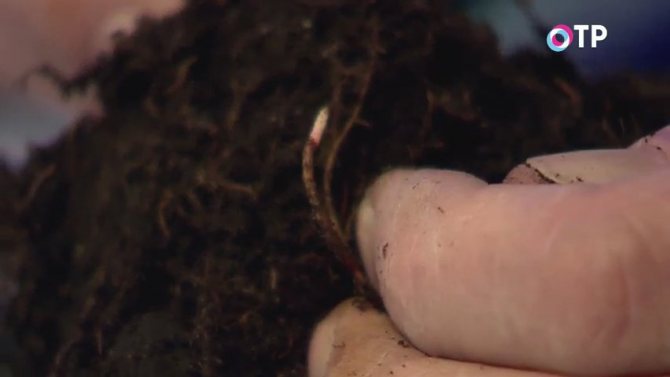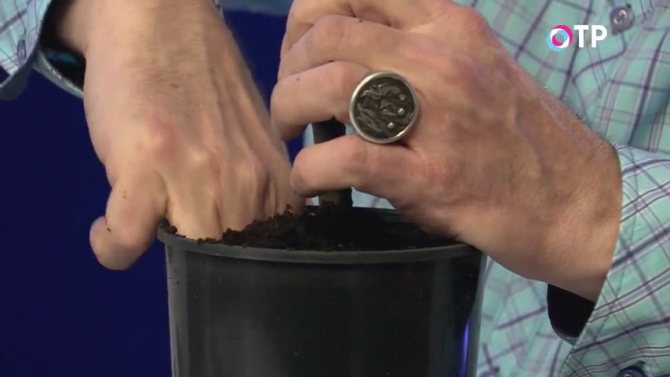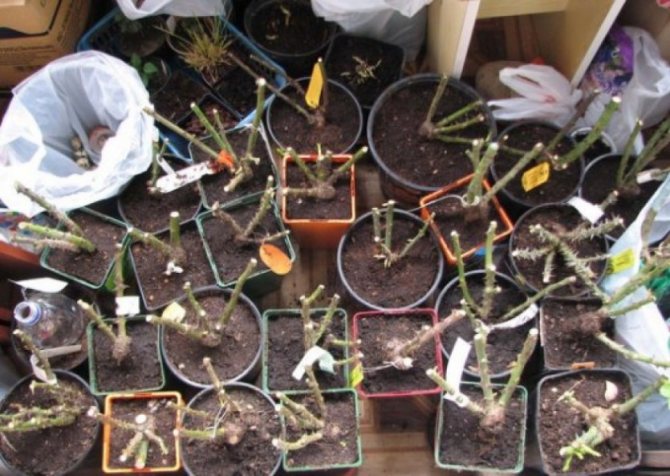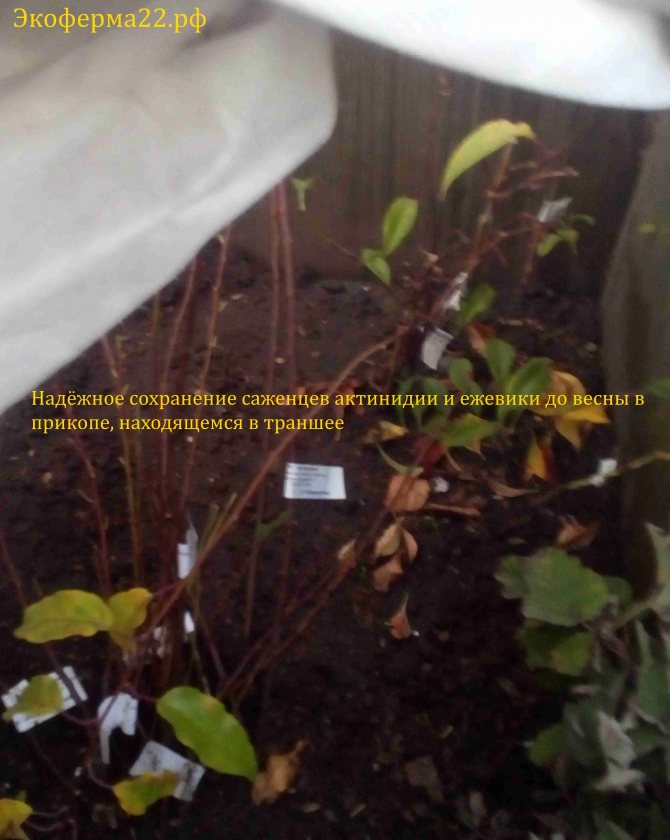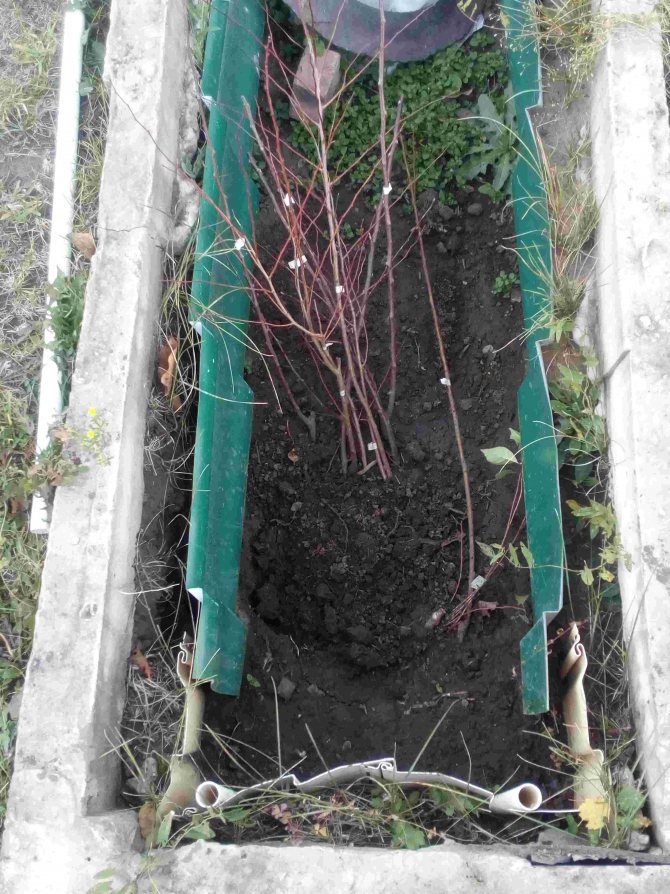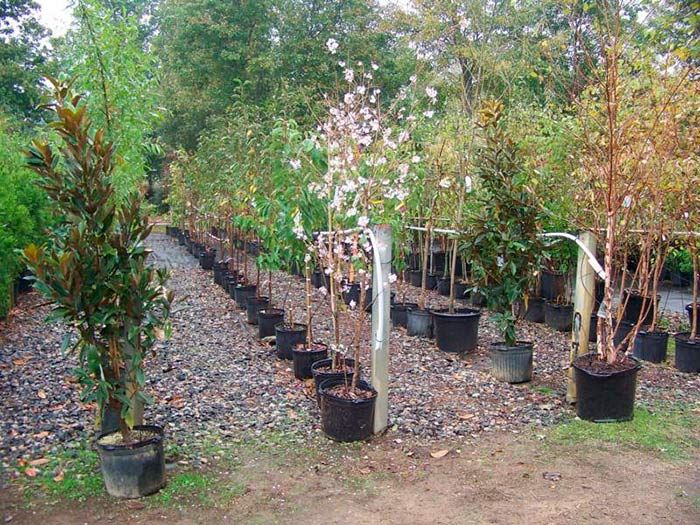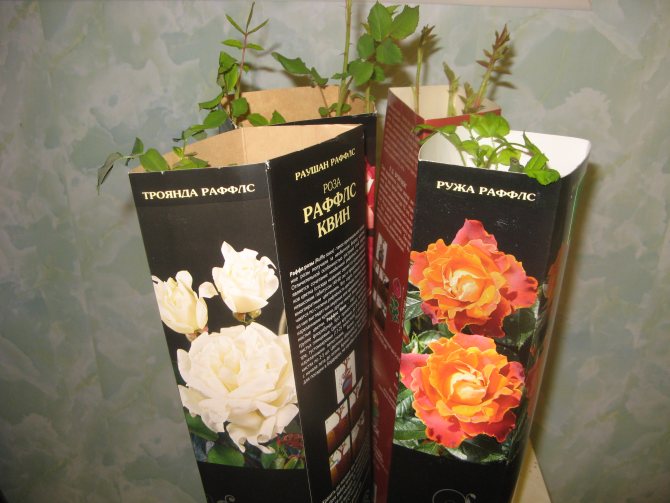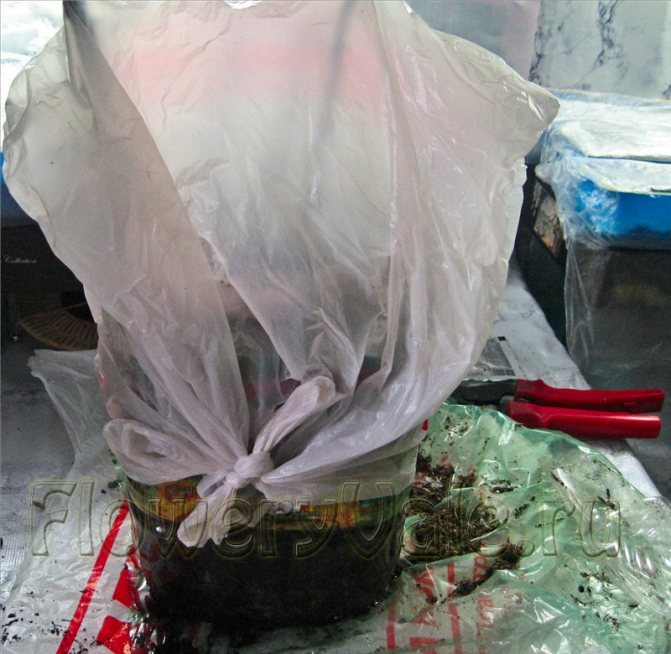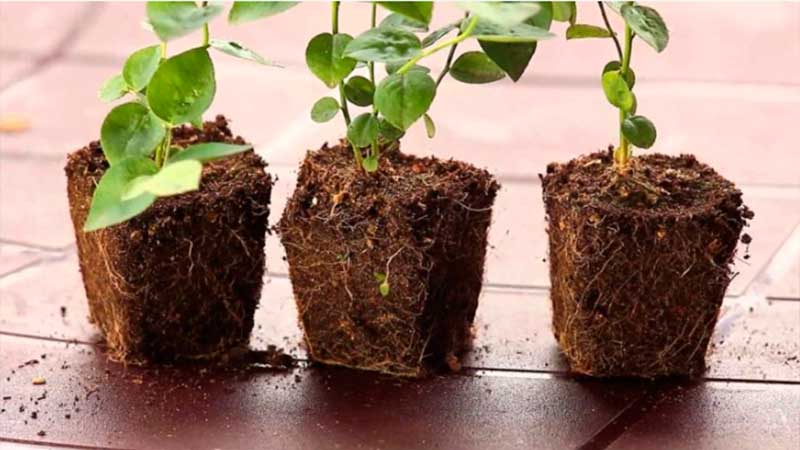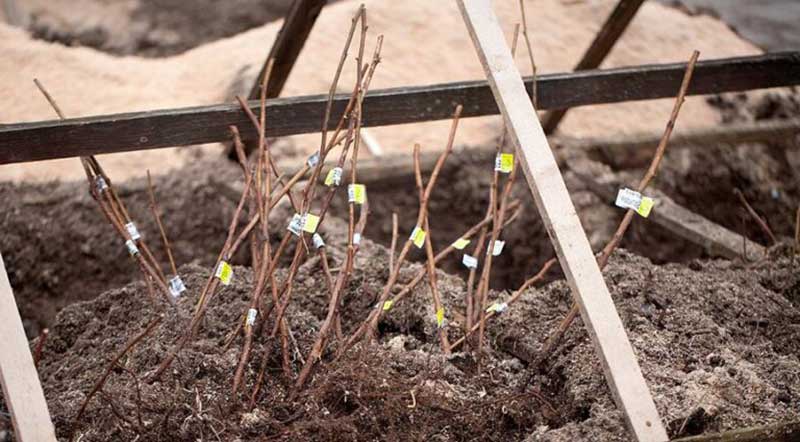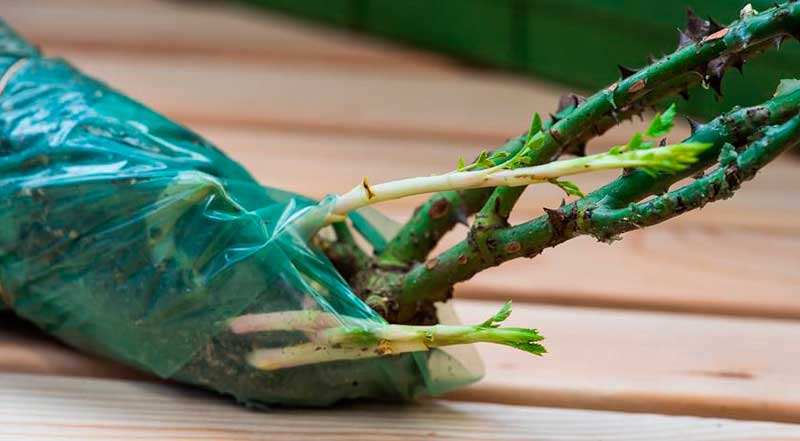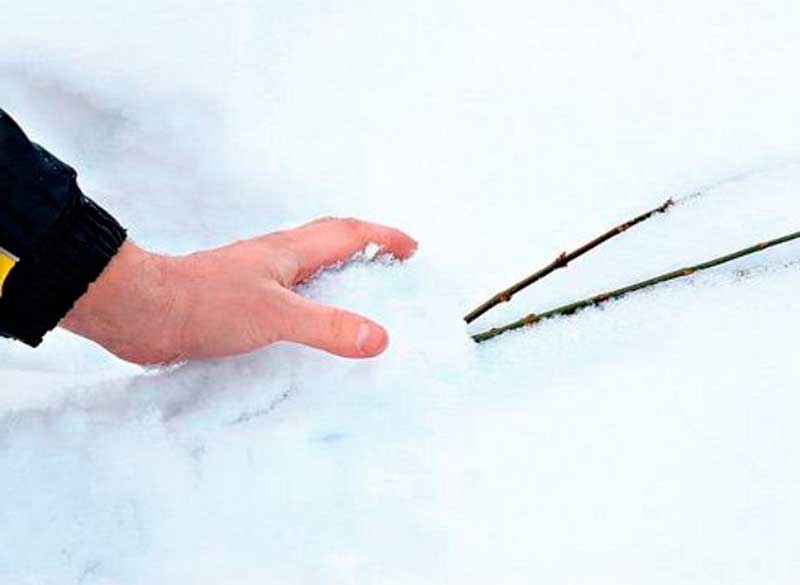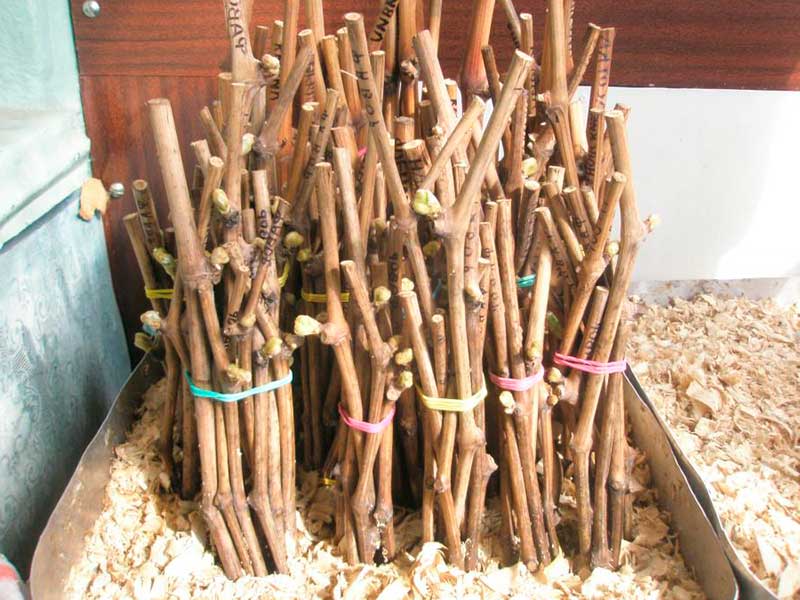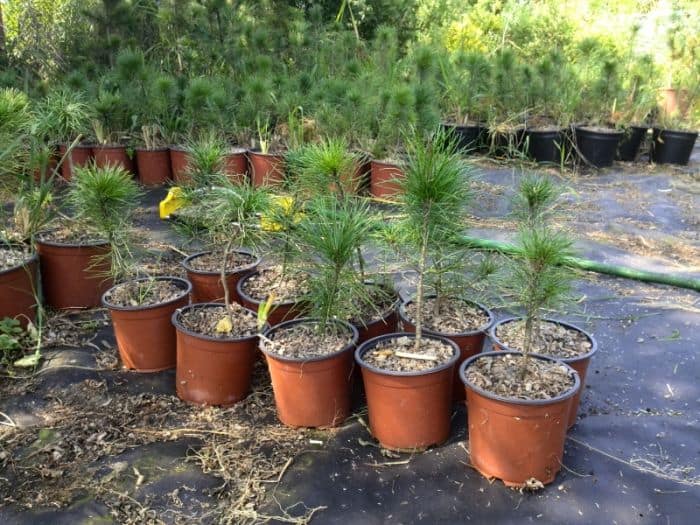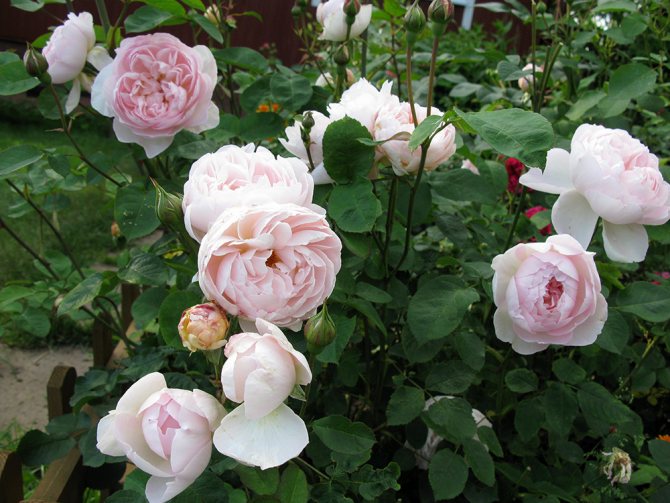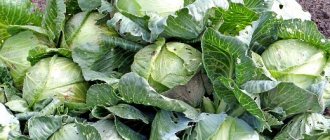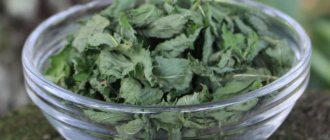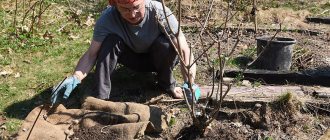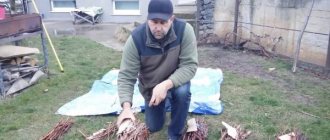EXCELLENT TOOL FOR MASTERS AND NEEDLEWORK AND EVERYTHING FOR THE GARDEN, HOME AND COTTAGE LITERALLY FREE + THERE ARE REVIEWS.
Buying plants is a responsible business. Let's talk about that. what you need to pay attention to when choosing seedlings of fruit and ornamental trees and shrubs
SPRING - TIME TO BUY PLANTS, BOTH FRUITS AND DECORATIVE. IT IS IMPORTANT NOT ONLY TO CHOOSE THE RIGHT TREE, SHRUB OR FLOWER, BUT ALSO PRESERVE IT BEFORE PLANTING IN THE GARDEN. LET'S TALK ABOUT THIS
We will learn to choose, store and plant planting material in the spring.
Seedlings grown in containers are easiest to transplant, their root system is well developed, not disturbed, such plants quickly take root and grow. It turns out that we simply transfer the plants: when we take them out of the container and plant them in the garden, we preserve the integrity of the root system.
Seedlings grown in the field, in the nursery, are often wrapped in film, after adding nutritious soil to the roots and forming a briquette, which is placed in a colorful package. The root system of such plants does not dry out; in this state, the seedling can be stored for several months.
How to dig in seedlings
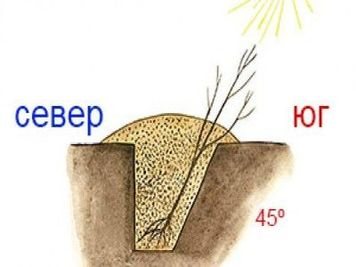
First of all, you need to choose a high and dry enough place where water will not stagnate. A trench, about 70 cm wide and 70 cm deep, is dug in such a way that the straight wall is located on the north side, and flatter on the south. The seedlings are carefully placed in the groove with their roots to the north and branches to the south.
Next, you need to cover the roots with dry earth, sand or peat in order to avoid the formation of air voids that cause the bark to dry out.
With the arrival of severe frosts, the tops of the seedlings, located above the pit, are sprinkled with earth, and later also with snow. You can also cover them with spruce branches or cut sedge so that the seedlings do not damage the mice. Protects from rodents and a meter strip of land cleared of snow, left around.
In the spring, the seedlings are opened as early as possible. It is not worth delaying with this, since the young bark can vomit. And already in early April, when the earth begins to warm up, new roots appear. If they are damaged, the process of adaptation of seedlings will be significantly delayed.
When and how to procure
With the help of grafting, you can rejuvenate an old tree, increase its yield. Also, you can cultivate an apple tree by grafting an apple stalk from a varietal tree. First of all, you need to learn how to harvest cuttings. Choose trees that have already begun to bear fruit and suit you with the quality and quantity of fruit. It is better to cut the cuttings from the shoots that grow on the south side of the apple tree. Ripe, but young shoots that grow on the middle tier of the crown are ideal for propagation by cuttings.
A sterile and very sharp pruner is used to cut the cuttings. The lower part of the cutting should be beveled, and the upper one should be straight. Suitable length - 30 cm. Average thickness - up to a centimeter. Such a branch must have developed buds!
Material can be harvested for rooting and planting in the future or for grafting. The best time to cut branches is late fall or early spring. Most gardeners choose to prepare cuttings in the fall. The main thing is to keep them until spring.


How to keep grape cuttings until spring
Save the cuttings in the cellar until spring
If you have a good cellar with a hood where you store vegetables, you can put grape cuttings in the same place. The roots must be covered with light, slightly damp soil. Sand, peat, coconut will do.
Moisture gradually evaporates even in the cellar, so check in winter if the soil is dry, or vice versa, if mold has appeared on it. In the first case, you need to pour clean water, in the second, spray it with iron vitriol or potassium permanganate. During storage, respiration occurs in the tissues of the cuttings, during which the nutrients accumulated in the tissues are consumed.
The higher the storage temperature, the more intensively the nutrients are consumed. If there is a high temperature in the storage area of the cuttings, then by the time the cuttings are planted for rooting, the nutrients may be completely consumed. The optimum temperature for storing cuttings is from 0 ° C to + 4 ° C and a humidity of 80%. Many growers recommend completely filling the cuttings with wet sand.
How to keep grape seedlings in the basement
You can store seedlings and grape cuttings in cold cellars. To prevent the cuttings from drying out during storage, you must wrap them in plastic bags. Before storing it, some growers recommend giving the vine water, or even soaking it. We do not do such a procedure.
We prefer to treat the bushes with copper preparations before pruning the vineyard to prevent diseases, and put the vine in storage immediately after pruning. The vine should not be wet, without leaves. Our vine is rooted almost 100% after storage.
How to keep cuttings in the refrigerator
If you do not have a cellar or a cold basement, then you can store grape cuttings in the refrigerator. It is suggested to wrap the cuttings in a damp, clean cloth, and then in a plastic bag. Refrigerators, especially old-style refrigerators, promote the active evaporation of moisture from the products stored in them, including cuttings. Therefore, you need to regularly check the condition of your cuttings in the refrigerator, and if necessary, moisturize the dried cloth.
On the Internet, there is a statement that if apples and pears are stored along with grape cuttings, then the eyes of such cuttings do not awaken. Apparently apples and pears emit gases during storage, which can destroy the buds in the eyes. How true this statement is - we do not undertake to judge, since in the cellar where the vine is stored, we store only seedlings. We use a separate cellar for storing vegetables.
If the seedlings "woke up"
The presence of living buds on a plant indicates its "awakening". You can save such roses until planting on the balcony. But if the growth of shoots is observed, then it is important to create all conditions for the normal development of a bush or cutting:
- The plant is freed from packaging or from wet paper in the case of cuttings, the name of the variety is attached to the stem.
- The roots are soaked in heteroauxin or Kornevin, following the instructions.
- A large container is selected for planting a rose (at least 5 liters) with a drainage system. For further planting in late spring, you will have to trim the bottom and side of the pot. Thus, it will be possible to preserve the roots of the plant and the earthy clod, which will have a positive effect on the future health of the flower.
- Choose a sunny or artificially lit place in the apartment. If possible, the pot is placed in a greenhouse in April.
- When planting in the spring, you need to monitor the safety of the earthen coma. If its integrity has remained unchanged, then it is not at all necessary to remove the buds. Otherwise, you will have to cut off all the buds and flowers.
How to keep raspberry seedlings until spring
Late acquired raspberry seedlings with the onset of severe frosts should be stored in slightly damp fresh sawdust and put in a plastic bag, leaving it open.
For the successful wintering of raspberry seedlings, the main thing is that at the time of laying the seedlings for storage, the seedlings have living roots of light brown color. Keep a bag of seedlings in a cold room in winter (for example, in a basement where vegetables are stored). The desired storage temperature for raspberry seedlings is not higher than + 4 ° C, in such conditions the seedlings are well preserved. Only you can’t feel sorry for them and water them; keep in mind that it is absolutely impossible to water raspberries stored in a cool place in winter.
Storage of fruit bushes
Shrub plants grown in a container (raspberries, currants, gooseberries, etc.) should be stored in the fresh air, in a shaded place, or at a low temperature in the cellar before planting.
Planting material from a nursery with open roots is immediately placed in a bag. In this case, the roots must be wrapped with a damp cloth. If the planting site is not yet ready, the seedlings can be dug in on the site. Their roots are covered with earth and moisturized well.
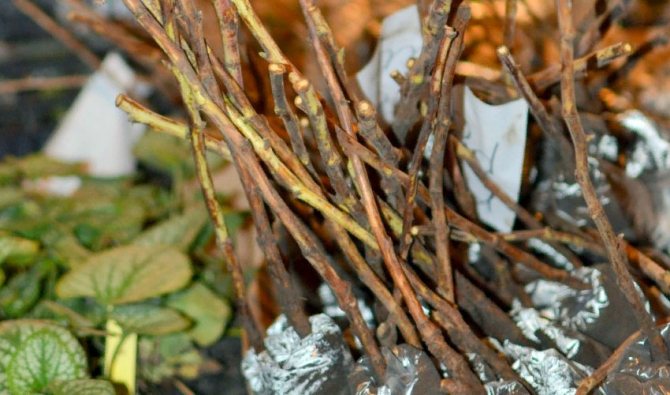

How to keep cherry seedlings until spring
Heat-loving stone fruit crops - peach, apricot, sweet cherry, mulberry, blackberry, etc. we plant only in spring, and until that time we store in a cold basement with roots dug into the sand.
How to keep cherry seedlings in the cellar?
Prepare a large container (depending on the number of seedlings), plant the resulting seedlings in it and cover their roots with damp sand (but not too wet). Store this container in a cold basement until spring. The best storage temperature is 0 ° C to -5 ° C.
Many refer to the fact that they live in city apartments, and that they do not have basements in their summer cottages. Then there is an easy way out. At a high, not flooded in spring, place of the site, dig a small pit about 1 meter deep. Place the obtained seedlings in it, sprinkle their roots with wet sand or soil, do not forget to put a seed from the mice. Cover the hole with planks and top with a layer of earth 30-40 cm thick. Leave a small vent. Falling snow will be an excellent protection against frost. In the spring, as soon as the snow melts, open the hole, and after the soil thaws, plant the seedlings in a permanent place. The result will be excellent, and the survival rate is almost 100%.
Preparation of seedlings
Purchased seedlings must be prepared for storage. The root system is carefully examined, the diseased and damaged parts of the roots are removed with pruning shears. Too long roots are cut to normal size. Places of cuts must be sprinkled with coal or treated with brilliant green. If there are traces of mold on the surface of the seedling, you will have to say goodbye to it. It is impossible to stop the development of mold, therefore, by the onset of spring, the young tree will be completely affected.
If you ordered a plant in the nursery, and it “drove” to you for some time, check the roots immediately - they may dry out on the way. If this happens, wrap them in a damp cloth. Seedlings with an open root system must be treated with an antiseptic - copper sulfate or foundation.
We save strawberry seedlings until spring
Strawberry seedlings (large-fruited strawberries) should, if possible, try to be planted in the ground, or at least dig in. In an apartment or a warm cellar, they do not tolerate the winter well. If the ground is already frozen, then you can bring it in a store or take the ground in a greenhouse. The planted bushes need to be mulched without falling asleep in the "heart". At stable negative temperatures, the plants will need to be insulated: with branches, spruce branches. The shelter should be lightweight and breathable. Strawberries very often suffer from damping in the winter.
If it is not possible to plant the plants in the ground, then the strawberry seedlings are stored in a cellar or refrigerator at 0 ° C ... + 6 ° C.If it is colder, the seedlings may freeze, at high temperatures they will start to grow. If the cellar is dry, you can spray the floors a little with water to increase the humidity.
Before storage
Often there are seedlings in which it is possible to see the roots with signs of fungal infection. The advice to sanitize them and trim them to healthy tissue does not always guarantee a complete recovery. Should you buy a plant that is known to be sick? If the root system of the planting material is wrapped in an opaque film or is in a pot, then we cannot immediately identify all the shortcomings.
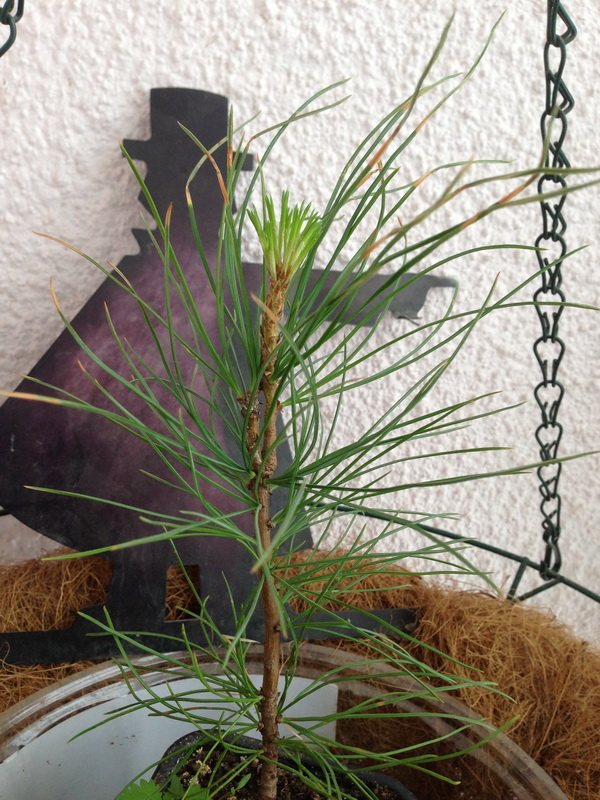

A pot with a cedar pine seedling in a hanging basket on a glassed-in balcony
A dried lump of earth with the roots of a seedling must be moistened immediately. Any option will work: watering, wrapping in a wet cloth, or briefly moistening in a bucket of water. After that, you need to wrap the root system of the seedling in a breathable film. If it is not there, then you can use any one in which holes are made for air intake, or take a suitable fabric. You may need to add fresh soil.
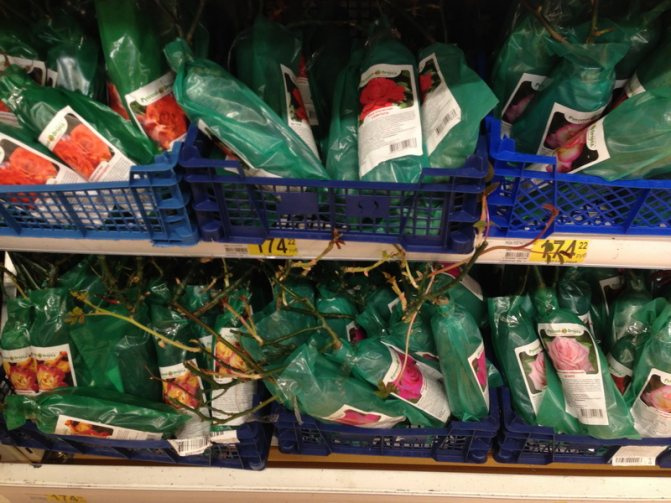

The root system of seedlings is often overdried
The vaccination site must be strong and healthy. For some plants (eg roses) it is important that it is covered with paraffin wax or grafting tape.
How to keep rose cuttings until spring
To preserve rose seedlings until warmth, you can use one of the following methods:
- Storing rose seedlings in a basement or cellar
- Cold storage
- Storage in a container indoors
How to keep rose seedlings in the cellar until spring
Roses can be stored well for 2 months in a basement or cellar with an air temperature of 0 ° C to 3 ° C. To do this, the seedlings are placed vertically in a bucket or any container and sprinkled with wet river sand, peat or sawdust. The main thing is that the root collar is slightly deepened.
Storing rose cuttings in the refrigerator
Rose seedlings are wrapped in several layers of newspaper and plastic, and then placed on the bottom shelf of the refrigerator. It is important to check the moisture content of the soil at the roots of rose seedlings: too wet soil can provoke rotting of the roots, and dry soil - drying out and death of the plant.
Storing roses in a container indoors
This is the extreme and most undesirable option, but the only possible one if the seedling has time to wake up and dissolve the leaves. To do this, young bushes must be planted in a container of sufficient size so that the roots can develop normally. It is also necessary to protect the roses from light so that they do not stretch upwards before their root system is strengthened. After planting the plants in loose soil, they must be packed whole in polyethylene and left in a room with a temperature of 10-15 ° C to slow down their growth. It is also important to monitor the moisture of the earthy coma.
Digging in the seedlings of roses in the snow
To do this, on an area with a constant snow cover, holes are dug into which rose seedlings in a package are placed. After that, the plants are sprinkled with purchased substrate and covered with spunbond. In this position, rose bushes will tolerate frost well, and will wake up along with other plants planted in open soil.
Keeping roses in a prikop
Here is how the experienced rose grower Theorina A.I. advises to store seedlings of roses with an open root system in a burial ground in winter:
“If you bought rose seedlings in late autumn (when the garden soil is already frozen), then it is better to store them in the basement - in boxes sprinkled with wet sand. In the absence of a basement, I keep such roses in a prikop. At a suitable place chosen for the ditch, I dig a trench 45-50 cm deep with a slope to one side, at the bottom of which I pour sand. On the inclined side, I lay seedlings of roses, having previously placed spruce branches under them.Before laying in the trench, the roots of rose seedlings are cut to 30-35 cm. Before the onset of winter, callus is formed on the cut roots of the roses, from which additional roots will develop in the spring. When laying roses in trenches, it is important that the grafting site be buried at least 10 cm. I cover the seedlings laid in a trench with sand, carefully spill it with water, and tamp it well (so that there are no voids between the roots). I cover it with earth from above, then cover it with spruce branches. Above the ditch, I install low arches of a dry shelter, reinforcing them with crossbars. I put roofing material on top, then a film, so that it is dry and warm in the shelter. In the spring, I throw the snow away and take off the shelter in time. I cover the rose seedlings with lutrasil and keep them that way until they are planted in the ground. "
Own-rooted roses (grown from cuttings) are very sensitive to soil freezing. Therefore, annual seedlings of such roses are kept in a cool basement, refrigerator or, in extreme cases, on a windowsill in an apartment (not near a radiator)
And in the spring, you will transplant the saved seedlings of roses to a permanent place in the open ground.
Dates of disembarkation in the fall: each has its own temperature
In order to understand whether you have time to plant seedlings in open ground, whether it is worth preparing them for winter and spring planting, you need to take into account not only the timing of autumn planting, the temperature of the air and soil, but also the features of the planted plants. In order not to be mistaken, you can use the general recommendations for disembarking:
- period - late September-mid-November. At the same time, fruit plants are planted until October 20, perennials and conifers - until December, because they are cold-resistant plants, roses and berry bushes - until October 10-15;
- soil temperature. Each fruit tree and berry shrub is already in hibernation in autumn, but it is capable of developing a root system at a soil temperature of + 3 ° C. And this temperature of the soil usually remains until November 15-20. Therefore, even if there is wind and rain outside, but the earth is warm, you can plant it;
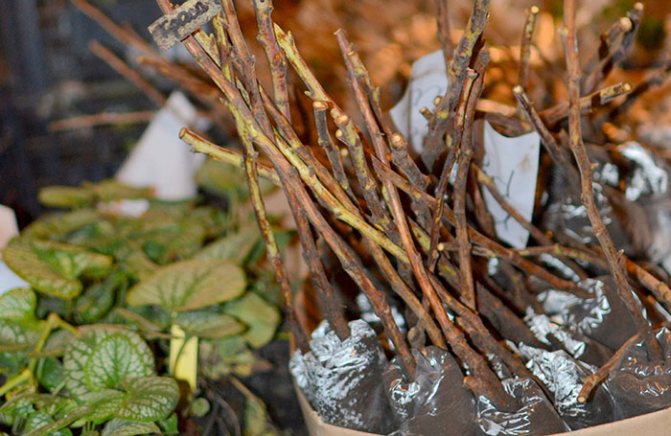

Plant trees and shrubs on time
- ambient temperature. The optimum temperature for disembarkation is + 7-12 ° C. With such indicators and warm soil, the plant is able to grow in 1-1.5 months a sufficient root system for comfortable wintering. This means that the new "inhabitants" of the garden will delight you in the spring with a healthy and blooming appearance.
Advice. It is not necessary to plant plants outside the time limits and temperatures. The culture will experience serious stress, will give all its strength to survive and will be engaged in recovery for the next year. And we need a young and healthy garden.
How to keep clematis until spring
How does this question answer Elena Grigoryan, an experienced florist, volunteer of the N.V. Tsitsin Main Botanical Garden:
The situation when clematis of an interesting and necessary variety comes across a florist only at the last autumn sale is quite common. And of course, a late date is not a reason to refuse a purchase.
But what to do with such clematis seedlings? First of all, do not forget to carefully study the label: in addition to the name of the variety, it usually indicates the desired height for trimming the whips for the winter (trimming group). After that, take the plant to the garden and dig it in, without removing it from the container, in a semi-shady place, not flooded in spring. The depth of the fossa is calculated as the height of the pot plus 10 cm - such a deepening will help keep the buds of renewal from freezing, from which new shoots will grow next year.
If the variety belongs to a group in which the lashes must be kept for flowering, then it is better to dig the pot at an angle to the ground, and put a little spruce branches under the lash. You don't need to cover them from above. Non-woven fabric will become a home for mice, and poorly ventilated shelters can lead to plant damping in the event of winter thaws. In the spring, after thawing the soil, plant clematis in a permanent place.
Planting seedlings in a flower pot
This option saved me many times when I bought a seedling that was woken up much ahead of time. I planted it in a tall flower pot filled with loose soil or neutralized high-moor peat. This option is suitable for the preservation of many crops in which active shoot growth has begun. Many of us have to buy planting material when it appears on sale. There may not be a chance to acquire the desired plants later. So, this year the pots with the cedar pine and Koniki spruce seedlings bought in February are waiting for planting in the ground on a glazed loggia.
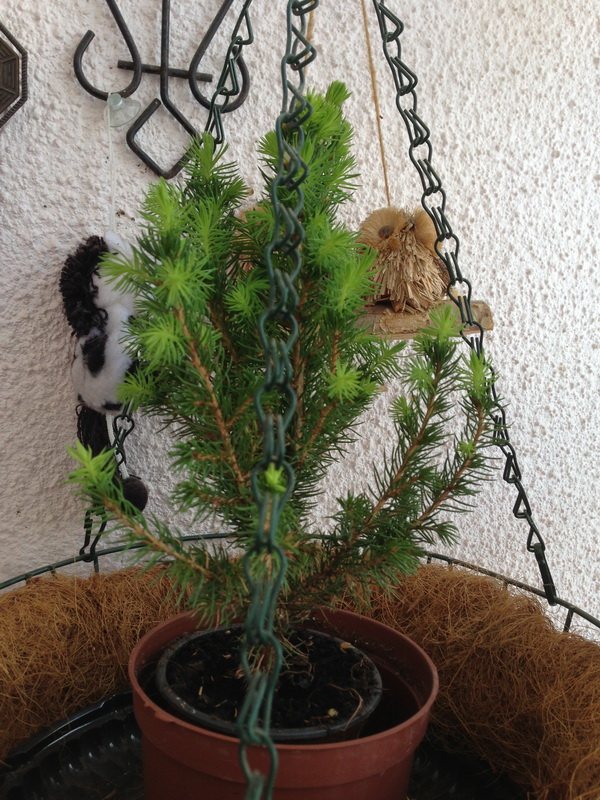

Koniki spruce seedling with young shoots is cozy in a hanging basket on a glassed-in loggia
A boxwood bush growing in a pot is waiting for spring on the windowsill. In May, I will transplant it into a spacious pot and put it in the garden or dig the pot into the ground on the site.
Several times I saved roses in this way, purchased with blossoming leaves. I really wanted to buy the variety I liked, so I took a deliberate risk.
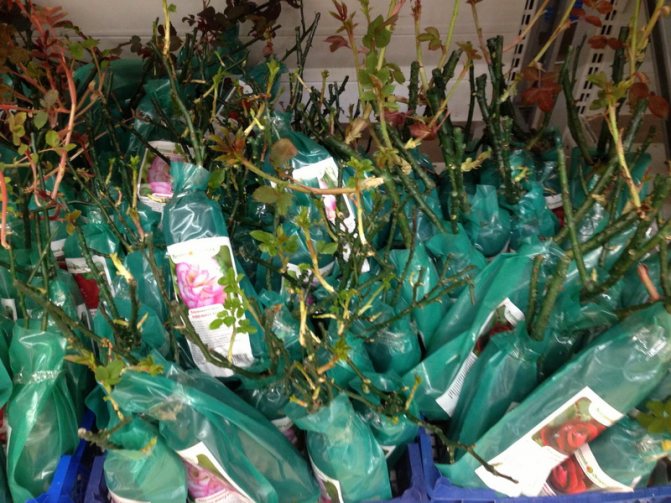

I even had to buy such rose seedlings
I planted roses in tall narrow pots filled with soil and put them on a glassed-in balcony. The seedlings were doing well. Only the threat of the appearance of a spider mite lay in wait for them. It is imperative to observe an important condition: all seedlings awaiting planting on a site in a flower pot must be in a bright place.
How to keep conifers until spring
Unlike fruit and berry crops, conifers do not winter well in the cellar, so it is better to drop them in the garden. But the first option should not be completely ruled out either.
Storing conifers in the garden
Conifers, as well as fruit and berry plants, can be dug in the garden, but not in a trench, but in pits, and without getting out of containers. The soil around the seedlings must be covered with earth or peat - such a layer will work as a heater. It is advisable to lay a plastic wrap on top so that the earth does not get wet. The green mass of conifers also needs to be protected from winter frosts - covered with non-woven material (for example, lutrasil).
Storage of conifers in the cellar
If the ground has already managed to freeze so much that it is difficult to dig a hole for planting a seedling, conifers will have to be stored in a cellar or garage. Then they need to be put in boxes or boxes and sprinkled with sawdust or peat. There is no need to cover the plants from above, but the boxes should be insulated. For this, felt or old clothes are suitable, which should be used to cover the boxes. During the winter, conifers need to be watered periodically to keep the soil from drying out.
In order to make the question of how to preserve seedlings until spring even more clear, we suggest that you familiarize yourself with the video:
Interesting articles on the topic "save in winter ..."
How to cover grapes for the winter correctly Cuttings for grafting [preparation and storage] Roses shelter for the winter and pruning Do perennial flowers cover for the winter, when and how to do it
Two types of preservation of fruit seedlings
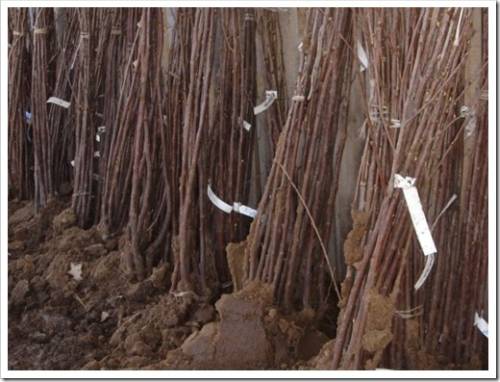

On the positive side, only two methods have proven themselves:
- retention in the groove;
- preservation in the refrigerator;
The first option is preferable, since not every summer resident can find a refrigeration unit suitable in size.
To keep the seedlings in the groove, it is recommended to proceed as follows. We choose a place that will be effectively protected from the wind. It is very important to minimize the risk of the seedling losing moisture.
For storage, use only soft sand (as fine as possible). It is quite possible to use muddy soil. The main thing is that it does not have stone inclusions (pebbles, etc.).
We protect the storage area from rodents with a metal mesh. We water regularly.The seedling should be stored exclusively in the shade. This will most effectively delay the process of kidney swelling. In general, this method is suitable for preserving seedlings until spring.
In a refrigerator
If the gardener does not have any of the above, then it is possible, as a last resort, to store the seedlings in the apartment. For this, a balcony or refrigerator may well be suitable. The latter should be large and completely free of food and shelves.
Preparation steps for storage in the refrigerator:
- In a specialized store, they buy nutritious soil for seedlings.
- The roots of each tree are dipped in a separate plastic bag.
- So much soil is poured so that it completely covers the roots.
- Lightly water the soil, immediately tie the bag.
- Several holes are made on top of the bag so that there is ventilation inside, otherwise the roots will rot.
- Set the temperature in the refrigerator from + 2oC to + 5oC.
- Carefully fill the refrigerator with seedlings so as not to bend them.
This method, for obvious reasons, is only suitable for small shrubs.
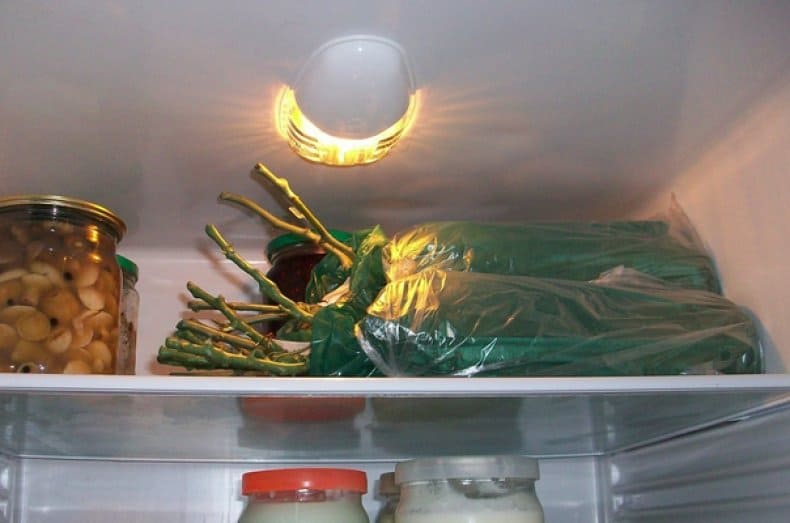

Coniferous plants
Coniferous plants are sold in containers with a soil substrate. Therefore, before planting, they are kept on windowsills as indoor plants. But so that the sun's rays do not dry out the needles, they choose a place that is not too lit, from the north side of the room.
So, storage of seedlings before planting in spring should take place in conditions of low temperature and moderate humidity, which slow down the growing season and prevent plants from growing ahead of time.
Which storage place to choose
In the ground
If frosts suddenly set in and the temperature of the earth dropped below zero, and the snow has not yet fallen, then you can hide the planting material in the ground. For the digging, dry, well-lit land, without groundwater, is chosen.
The prikop is recommended to be done in dry weather:
- First, they dig a hole or a whole trench about 50 centimeters deep. The width should be about 30 centimeters, and the distance between the seedlings should be at least 25 centimeters.
- At the bottom of the pit, sawdust or coniferous branches are placed in a layer of about 10-15 centimeters.
- In order for the tops of the seedlings to be under the sun's rays all winter, the roots should look north when laying, and the tops to the south.
- For softness, a pit or trench is covered with sand and peat in the same proportion.
- Make sure that the rhizomes are carefully hidden in the ground.
- All this is thoroughly watered.
- Top it up with soil slightly, since after watering the bottom layer sagged.
- Do not touch all this until spring.
Thus, most gardeners keep fruit shrubs and trees until spring.
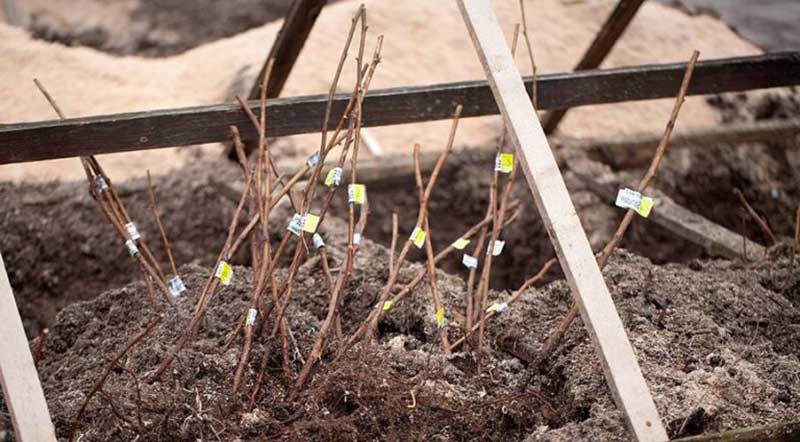

Under the snow
Despite its coldness, snow is a great shelter for most plants. It has been noticed that if the shrub does not cover a thick layer of snow, then in the fierce winter it dies.
The best thickness of snow is considered to be a layer of 15 centimeters or more.
The procedure for digging in the planting material under the snow is very simple:
- The seedlings are kept in a bath full of water for several hours.
- All leaves are carefully removed from the branches.
- A place with the most snow is chosen.
- They roll out the hole, grabbing a few centimeters of soil.
- All planting material is wrapped in plastic wrap.
- They are placed in the hole with the roots down at an angle of 45 degrees.
- First, they cover it with soil that was dug out of the hole.
- Then they thoroughly bury it with snow.
- To prevent the snow from melting quickly, a 10 cm layer of sawdust is poured on top.
This method is ideal for fruit and rose seedlings.


In the basement
This method is suitable for gardeners living in apartment buildings, which necessarily have a basement for storing personal belongings. If the basement is heated, then it is not suitable for long-term storage of planting material.
The basement should be cold and damp. Ideally, the air temperature should be at zero degrees, slight fluctuations are allowed.
If the space allows, the seedlings are laid out on the floor, and their roots are covered with wet sand. Throughout the winter, you need to ensure that this sand is slightly damp, but not dry or very wet. As a last resort, the trees can be placed in boxes of wet sand. In this way, you can store not only fruit bushes, but also strawberry seedlings.
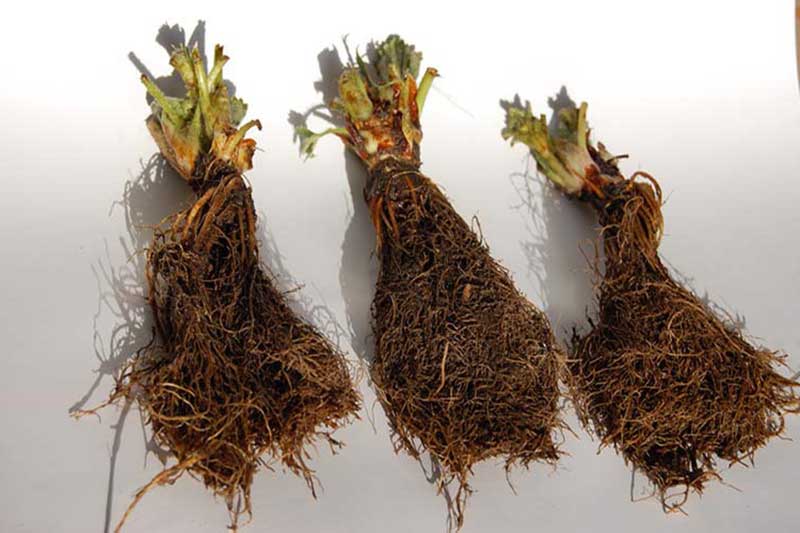

In the cellar
It is almost always cold and humid, and therefore is an ideal place for long-term storage of almost any seedlings. Before storage, their roots are dipped into any moist soil: sawdust, sand, peat.
The main thing is that it is not too wet, otherwise the root system can rot. Throughout the winter, it is advisable to check the moisture content of the soil, add water if necessary by spraying.


In a refrigerator
If the gardener does not have any of the above, then it is possible, as a last resort, to store the seedlings in the apartment. For this, a balcony or refrigerator may well be suitable. The latter should be large and completely free of food and shelves.
Preparation steps for storage in the refrigerator:
- In a specialized store, they buy nutritious soil for seedlings.
- The roots of each tree are dipped in a separate plastic bag.
- So much soil is poured so that it completely covers the roots.
- Lightly water the soil, immediately tie the bag.
- Several holes are made on top of the bag so that there is ventilation inside, otherwise the roots will rot.
- Set the temperature in the refrigerator from + 2oC to + 5oC.
- Carefully fill the fridge with seedlings so as not to bend them.
This method, for obvious reasons, is only suitable for small shrubs.
On the balcony
The most ideal storage space is the north-facing glazed balcony. On the south side, the temperature on the balcony can fluctuate during the daytime due to the sun. And if the balcony is open, then the trees are stored as close to the wall of the building as possible, additionally covered with cardboard or burlap.
From the moment the planting material was arranged on the balcony, it is impossible to bring them into the apartment even for five minutes until spring. In this way, you can store any planting materials, if space permits.




